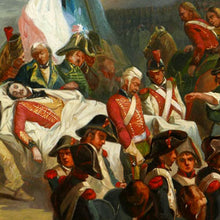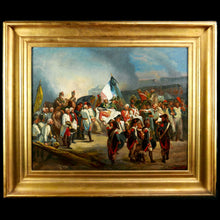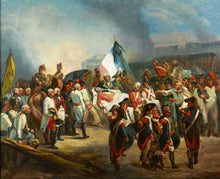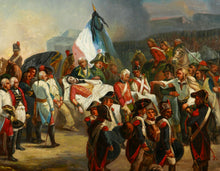The Death of General Marceau at Altenkirchen - 19th Century French School
SOLD
Tax included.
Adding product to your cart
Overall: 66cm (27in) x 78cm (30.7in)
Oil on canvas. After Nicolas Toussaint Charlet (1792-1856). General Marceau amidst mourning friends and foe under the black draped tricolour of Revolutionary France. Signed ‘Bertrand’ lower left. Canvas: 49cm (19.3in) x 60cm (23.6). Contained in period gilt wood frame.
General Marceau, champion of liberty, numbered among France’s most heroic commanders before Napoleon monopolised the position. After the failure of Rhine Campaign of 1796, Marceau covered Moreau and Jourdan's retreat and fought the desperate Battle of Limburg on the Lahn River. While conducting a successful rear guard action near Altenkirchen on 19 September, he was mortally wounded. He died two days later in the early morning, aged only twenty-seven. The Austrians competed with Marceau's own men to honour the dead general. His body was burned and the ashes placed under a pyramid in Coblenz designed by his comrade in arms Jean Baptiste Kléber. They were transferred to the Panthéon in 1889.
Marceau’s life and death became a source of inspiration to Romantic Movement. Marceau was immortalised in Canto III of Lord Byron’s Childe Harold’s Pilgrimage, wherein the traveller narrator gushes over the youthful general's tomb in stanzas 56 and 57. Marceau’s end was thus an attractive proposition for a painting by the Romanticist Nicolas Toussaint Charlet (1792-1856), of which the present work by the unknown ‘Bertrand’ is a 19th century reworking.
General François-Séverin Desgraviers-Marceau, to give him his full name, (1769-1796), was the son of a prosecutor. At the age of sixteen he enlisted in the Angoulême Infantry Regiment. Whilst on leave in Paris in 1789 he took part in the Storming of the Bastille, and with the onset of the Revolution quit the royalist army. In July 1792 he was commissioned as a captain in a battalion of citizen volunteers in the defence of Verdun. Lack of revolutionary zeal amongst his men however attracted the attention of the revolutionary authorities and he was arrested and imprisoned with other officers suspected of counter-revolutionary sympathies.
On his release Marceau rushed to the defence of Saumur against the Vendéean royalists and distinguished himself in battle by rescuing a National Assembly ‘representative on mission’ from the hands of the insurgents. Rapid promotion followed and he was made General of Brigade following the Battle of Chantonnay in 1793. In October he distinguished himself in the Battle of Cholet, and began his friendship with Jean Baptiste Kléber (1753-1800). Both were soon promoted General of Division, and together they crushed the Vendean rebels at the Battles of Le Mans and Savenay in December 1793.
In the wake of Le Mans, Marceau rescued and protected a young Royalist lady, Angélique des Mesliers, with whom it is supposed he fell in love but whom he could not save from the guillotine. Marceau and Kléber themselves were arrested but saved from execution only by the intervention of Bourbotte - the Assembly Member Marceau had saved at Saumur. Around this time Marceau became engaged to Agathe Leprêtre de Châteaugiron, but the marriage was prevented by his constant military employment, broken health and family opposition. After spending the winter of 1793–94 in Paris, Marceau accepted a command in the army under Jean-Baptiste Jourdan, alongside Kléber, and took part in the battles around Charleroi. He had a horse shot under him at the battle of Fleurus and further distinguished himself at Jülich, prior to his final campaign.
Charlet, the painter of the original, was best known as the maker of lithographs, many of them with subjects harking back to the glories and disappointments of the First Empire. The anti-climax of the post Revolutionary and Napoleonic Wars was a condition he knew well as the orphan of a Dragoon of the Revolutionary Army.
Use left/right arrows to navigate the slideshow or swipe left/right if using a mobile device










